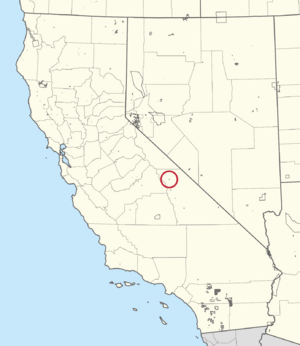Big Pine Paiute Tribe of the Owens Valley facts for kids
The Big Pine Band of Owens Valley Paiute Shoshone Indians of the Big Pine Reservation is a Native American tribe recognized by the US government. They are made up of Mono and Timbisha people. Their home is in California, near the eastern base of the Sierra Nevada mountains.
The Big Pine Reservation is about 18 miles (29 km) from Bishop. The tribe's main office is in Big Pine, California. There are 462 enrolled members in the tribe. In 2010, the reservation had a population of 499 people.
Contents
Language of the Big Pine Paiute
The Owens Valley Paiutes traditionally spoke a dialect of the Mono language. This language is part of the Western Numic branch of the Uto-Aztecan language family. Even though very few people speak it now, the language is still alive. In their own language, they call themselves Numa, which means "People." The Shoshone people in the community spoke the Timbisha language. This language is part of the Central Numic branch of the Uto-Aztecan language family.
Traditional Culture and Life
The Owens Valley Paiute people lived in groups that worked together. They had semi-permanent camps. Their culture blended ideas from both Californian and Great Basin Native American traditions. They grew crops using irrigation along the Owens Valley. This area was very fertile and had many different types of plants and animals. They called themselves Numa, meaning "People."
The tribe enjoyed round dances and held yearly harvest festivals. Girls had special ceremonies when they became young women. When someone passed away, they had a ceremony called "The Cry." This ceremony included a ritual face washing after a year of mourning. The tribe had both male and female healers, known as medicine people. Hereditary chiefs led the tribe's group activities. An "Irrigator" was an elected position in the tribe. This person managed the water for farming.
Important foods included Indian ricegrass and pine nuts. Hunting added to their farmed foods. They hunted rabbits, quail, and deer, especially in the summer. The tribe also fished for suckers, minnows, and pupfish. They also ate brine shrimp. Caterpillar larvae were baked and dried for food. Wild foods like acorns, cattails, and berries were also gathered.
Popular traditional games included shinny, the four-stick game, hoop and pole, and dice games. The handgame is still very popular today.
History of the Big Pine Paiute
In the early 1800s, European-Americans, like fur trappers and gold miners, met the Owens Valley Paiute. US military surveyors explored the area in the mid-1800s. They planned to create a reservation for the local Native Americans. Non-Native settlers moved into the valley in 1861. More and more European-Americans fought with the tribe for water and farmland.
A military outpost called Camp Independence was built in 1862. The non-Native settlers fought with the tribes. They destroyed the tribes' crops and took the best lands.
In the early 1800s, there were about 7,500 Paiutes in total. Around 1,500 to 2,000 of them were Owens Valley Paiutes. By the 1990s, an estimated 2,500 Owens Valley Paiutes lived on reservations.
The Timbisha (Panamint or Death Valley Shoshone) Native Americans moved from their original lands to live with the Owens Valley Northern Paiute. A reservation was not officially created until 1912.
To provide water for the growing City of Los Angeles, water was moved from the Owens River in 1913. This water went into the Los Angeles Aqueduct. This greatly changed the cultures and environment of the Owens River Valley. From the 1910s to the 1930s, the Los Angeles Department of Water and Power bought much of the valley. They did this to control water rights. This action greatly harmed the local economy. In the 1940s, the US federal government built houses and water systems on the Indian lands.
Big Pine Reservation Today
The Big Pine Reservation was created in 1912. It is about 279 acres (1.13 km2) in size. It is located along US 395 in the desert town of Big Pine, California. Many of the homes in the area were built by the Indian Housing Authority. There is a school next to the reservation. It has classes from kindergarten to 12th grade. A public library with 1,500 books is located inside the school. Tribal members also raise horses on the reservation lands.
Current Tribal Council
The Big Pine Band of Owens Valley Paiute Indians has an elected Tribal Council. This council has five members. They handle tribal business, manage money, and provide services. These services include education, utilities, housing, and social support. The council also works to preserve the tribe's heritage and protect the environment. The current positions are:
- Cheyenne Stone, Chairperson
- Deanne Cheshire, Vice Chairperson
- Tawny Williams, Member-At-Large
- Ashlee Dondero, Treasurer
Environmental Department
The Big Pine Band of Owens Valley Paiute Indians has an Environmental Department. Its main goals are to:
- Plan for environmental protection.
- Keep residents and visitors healthy and safe.
- Follow environmental laws and rules.
- Work to protect the water, air, and land.
The staff of this department includes:
- Sally Manning, Environmental Director
- Noah Williams, Water Program Coordinator
- Cynthia Duriscoe, Air Program Coordinator
- Gregory Spratt, Solid Waste Technician
- Joe Miller, Community Garden Specialist
Big Pine Paiute Development Corporation
The Big Pine Paiute Development Corporation (BPPDC) is a business group. It was created by the Big Pine Paiute Tribe. It has a five-member board. This corporation helps the tribe's economy grow. Its goal is to help the tribe become self-sufficient. It also works on business development and creating jobs for tribal members. All of this helps improve the quality of life for the Big Pine Band of Owens Valley Paiute tribe's citizens.
Education
The Big Pine Unified School District serves the reservation.


